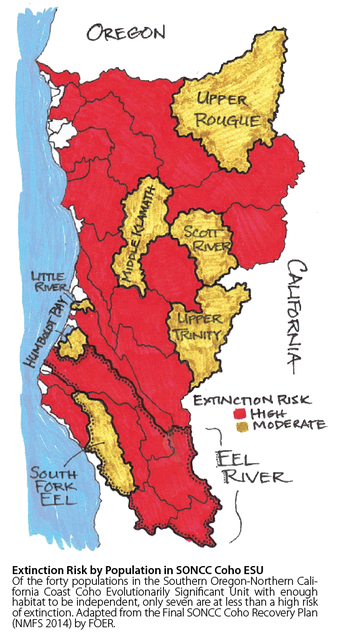A long-anticipated federal recovery plan for coho salmon in northwestern California and southwestern Oregon[1] was released in its final form this September. The plan says the continuing decline of the South Fork Eel River’s population of coho must be reversed, and the watershed’s runs recovered, to meet the Endangered Species Act’s goal of protecting the regional population from extinction.
It calls for greater protection and restoration of coho habitat throughout the watershed, and for change in the trajectory of rising impacts associated with the Green Rush of marijiuana cultivation. But the plan’s sobering assessments arguably understate the need for action, not least because it does not reflect the impacts of recent historic drought.
The recovery plan acknowledges the history of cumulative impacts, from overfishing and the draining of the Eel River estuary, to the great logging and roadbuilding boom of the mid-20th Century, impacts which drove silver salmon in the Eel River to the brink of extinction, and have only begun to be healed.
The plan made headlines, however, for its candor that today, it is the cumulative impacts of sediment discharges and water diversions related to large-scale marijuana cultivation that rank among the most urgent problems which must be solved if the South Fork Eel’s coho are to be given even the chance to recover. The document provides essential context for some of the most important decisions facing Humboldt County and the region, regarding not only always-contentious issues like water diversions, land use and development, but regulation of an industry that has evolved under legal prohibition.

As Julie Weeder, NMFS’ Coho Recovery Coordinatoor, explained in an interview with me on KHSU’s EcoNews Report, federal recovery plans serve as road maps to recovery, detailing and prioritizing actions that need to be taken, and goals which must be met, before a species can be “delisted” when no longer at risk of extinction. What Recovery Plans are not is enforceable; they don’t require anyone to do anything. Rather, they are meant to guide decisions about what recovery actions are most urgent, what critical impacts most important to reduce and mitigate.
And indeed, how we manage land and water use, in the South Fork Eel River and across the region, will be critical in determining whether these incredible, resilient fish, the product of at least six million years of coevolution with these rugged rivers, will continue to exist in our grandchildren’s lifetimes. The South Fork, described in the plan as once “the largest producer of coho salmon in the Eel River basin, and perhaps one of the largest producers in all of California,” with average spawner counts estimated from 15-17,000 fish annually at Benbow Dam in the 1930s, probably saw more than two thousand adults return in the best recent years with great ocean conditions, but has on the whole likely continued to decline even from a 1991 estimate of 1,320 spawners across the watershed.
It could certainly be worse: at least the South Fork’s population still appears above the roughly 464 estimated as the depensation threshold – the point beyond which a run will suffer impacts from scarcity, as fish find habitat but not mates. And it remains, despite its decline, “the largest and most stable in the Interior Eel River diversity stratum,” one of the key populations designated as “core” to the ESU as a whole.
But it needs to be a great deal better before we can afford to be sanguine about South Fork coho salmon: the plan states “to contribute to stratum and ESU viability, the South Fork Eel River core population should have at least 9,300 spawners.” The last record we have of that many coho adults in the South Fork Eel River was the roughly 13,000 counted at Benbow Dam in 1963. The next December’s disastrous flood not only hammered that year’s coho cohort, but reshaped the river, filling channels with sediment that poured off a heavily logged and roaded landscape.
Even as those legacy impacts linger, the recovery plan calls out sediment generated by roads and other clearings as a problem today. The plan links many of these sources of excessive sediment with unreported, unmanaged water diversions as consequences of the failure to effectively regulate large scale marijuana production. Of course, as practical questions, we know how to avoid and abate sediment-bleeding land uses, and how to store water during winter flows and forbear from summer diversions; what remains is to insure this knowledge is used to reduce impacts on our watersheds. Local regulations for marijuana cultivation are likely to offer the best opportunity to structures rules and incentives to most effectively secure watershed protection – and coho recovery – in the South Fork Eel River and across the region.
[1] The recovery plan was developed by the National Marine Fisheries Service (NMFS), aka “NOAA Fisheries,” the federal agency charged with protection of anadromous (sea-run) fish under the Endangered Species Act. It covers coho runs from Oregon’s Rogue River south to the Eel River, under the ungainly label of the Southern Oregon – Northern California Coast (SONCC) Evolutionarily Significant Unit (ESU).
By: Scott Greacen
Published: December 2014 in Econews
